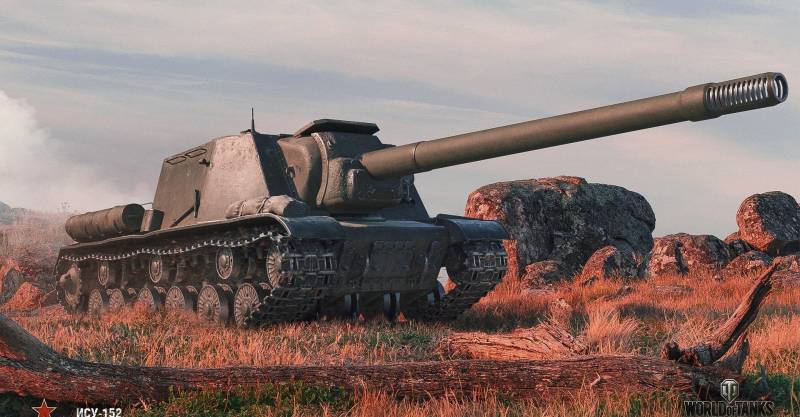ISU-152: inside the Soviet legend
ISU-152 is built on the basis of heavy tanks IP series. The frontal part of the first models was cast, but later changed to welded. On both sides of the impressive 152-mm gun there are loopholes through which the crew could fire from their personal weapons... Also in the front of the vehicle are tow hooks and spare tracks, and grilles are installed on the headlights (in the ISU-152, modernized after the Second World War).
Moving along the starboard side of the hull, you can see a small shelf for a set of tools (post-war modification), loops for attaching a canvas cover for a gun mask, parking lights and entrenching tools. The side sheets of the deckhouse, 75 mm thick, are positioned at an angle of 15 degrees in the vertical projection, and also curved inward in the horizontal projection. Closer to the stern, additional fuel tanks are installed, which are connected by fuel lines to the internal tanks. Exhaust pipes can also be seen there.
There is a place for a log on the left side of the car. This is a post-war modification that could only be seen on Soviet vehicles. If the car got stuck in the mud or sat on the bottom, a log was attached to the front of the tracks. This made it possible to move forward about half the length of the caterpillar and continue moving.
The armor at the rear of the hull is angled. 2 hatches allow access to the transmission, however, for more detailed maintenance, you will have to unscrew a few bolts around the perimeter of a special steel panel. For full service, you will need to unscrew even more bolts and remove the entire rear panel. Also in the aft are fuel tanks, tow hooks and parking lights.
The chassis of the self-propelled gun is the same as that of the IS series tanks. On each side there are 6 rollers with internal shock absorption and individual torsion bar suspension. Each roller has a rocker arm bump stop that prevents it from moving up too much and breaking the torsion bar. Slightly to the left and above the third roller is a hatch through which it was convenient to load 152-mm shells. The tracks are 650 mm wide and consist of single-finger tracks. In turn, each finger is secured with a clip and a washer. The track tension can be adjusted with a wrench while moving the sloth.
The ISU-152 is equipped with a V-2IS diesel engine with a power of 520 hp. The car also has a multi-cyclone air filter. A filter heater was often used to start the engine in very cold weather. In addition, the self-propelled gun has a compressed air engine start system. The engine compartment vents are located on the sides of the top of the chassis. A small dome of the cooling system is located between them. On the back of the case, you can also see the thick steel caps for the oil and fuel filler caps.
In the central part of the wheelhouse there are hatches for the commander and the driver. An armored fan casing is visible between them. In the rear of the wheelhouse, on the loader's side, there is a large double-leaf hatch through which it is easy to get inside the vehicle. To the right you can see another loophole for shooting from personal weapons. In addition, a pivot for a machine gun could be installed on the wheelhouse.
ISU-152 was produced until 1947. During this time, 2825 vehicles were built. The lack of 152-mm howitzers led to the fact that 122-mm A-19 guns were installed on some self-propelled guns. They were ISU-122. In general, the ISU-152 can be called a good combat vehicle: it was comfortable for almost all crew members, it was easy to repair and maintain, and this self-propelled gun could easily destroy almost any target.
For more details about the famous self-propelled gun, as well as the internal structure of the ISU-152, see the video from Wargaming.

Information